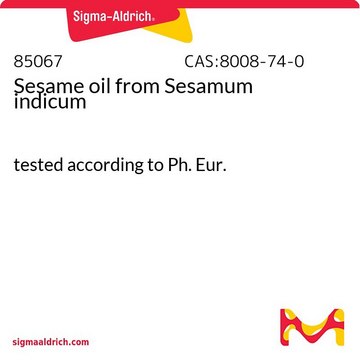88597
Peróxido de hidrógeno solution
3%, suitable for microbiology
Sinónimos:
Catalase Test, Catalase Test, H2O2
About This Item
Productos recomendados
agency
according to GB 4789.30-2016
according to ISO 10272-1:2017
according to ISO 10272-2:2017
according to ISO 11290-1:2017
according to ISO 11290-2:2017
Quality Level
vapor pressure
23.3 mmHg ( 30 °C)
assay
2.8-3.2% (redox titration)
form
solution
shelf life
limited shelf life, expiry date on the label
storage condition
protect from light
concentration
1-5%
technique(s)
microbe id | specific enzyme detection: suitable
color
colorless
pH
6-8 (25 °C)
mp
0.0 °C
density
1.000 g/cm3
application(s)
clinical testing
environmental
food and beverages
veterinary
microbiology
suitability
Pneumococcus spp.
Staphylococcus spp.
bacteria
SMILES string
OO
InChI
1S/H2O2/c1-2/h1-2H
InChI key
MHAJPDPJQMAIIY-UHFFFAOYSA-N
¿Está buscando productos similares? Visita Guía de comparación de productos
General description
Application
- Disinfectant: Hydrogen peroxide can be used as a disinfectant for surfaces, materials, and equipment in microbiology labs. When applied to surfaces, hydrogen peroxide reacts with organic materials, such as bacteria and fungi, and destroys them through oxidation.
- Sterilization: Hydrogen peroxide is often used in sterilization procedures in microbiology, especially in the pharmaceutical and medical industries. It effectively kills spores that are resistant to many other types of disinfectants.
- Microbial detection: Hydrogen peroxide can be used to detect catalase activity in bacteria, making it useful in microbial identification and differentiation. The species of bacteria may be distinguished based on their ability to catalyze the breakdown of hydrogen peroxide.
Storage Class
12 - Non Combustible Liquids
wgk_germany
WGK 1
flash_point_f
Not applicable
flash_point_c
Not applicable
ppe
Faceshields, Gloves, Goggles
Elija entre una de las versiones más recientes:
¿Ya tiene este producto?
Encuentre la documentación para los productos que ha comprado recientemente en la Biblioteca de documentos.
Artículos
On the Trail of Campylobacter
Chromogenic media enable the selective detection of S. aureus, which produce bluish-green colonies that are clearly differentiated from other species.
For microbiologists the most fundamental stain was developed in 1884 by the Danish bacteriologist Hans Christian Gram.
Sigma-Aldrich.com presents an article concerning Differentiation of Escherichia coli from coliforms.
Nuestro equipo de científicos tiene experiencia en todas las áreas de investigación: Ciencias de la vida, Ciencia de los materiales, Síntesis química, Cromatografía, Analítica y muchas otras.
Póngase en contacto con el Servicio técnico



